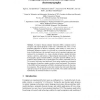Free Online Productivity Tools
i2Speak
i2Symbol
i2OCR
iTex2Img
iWeb2Print
iWeb2Shot
i2Type
iPdf2Split
iPdf2Merge
i2Bopomofo
i2Arabic
i2Style
i2Image
i2PDF
iLatex2Rtf
Sci2ools
ECCV
2006
Springer
2006
Springer
Computing Emotion Awareness Through Facial Electromyography
To improve human-computer interaction (HCI), computers need to recognize and respond properly to their user's emotional state. This is a fundamental application of affective computing, which relates to, arises from, or deliberately influences emotion. As a first step to a system that recognizes emotions of individual users, this research focuses on how emotional experiences are expressed in six parameters (i.e., mean, absolute deviation, standard deviation, variance, skewness, and kurtosis) of physiological measurements of three electromyography signals: frontalis (EMG1), corrugator supercilii (EMG2), and zygomaticus major (EMG3). The 24 participants were asked to watch film scenes of 120 seconds, which they rated afterward. These ratings enabled us to distinguish four categories of emotions: negative, positive, mixed, and neutral. The skewness of the EMG2 and four parameters of EMG3, discriminate between the four emotion categories. This, despite the coarse time windows that were...
Related Content
| Added | 22 Aug 2010 |
| Updated | 22 Aug 2010 |
| Type | Conference |
| Year | 2006 |
| Where | ECCV |
| Authors | Egon L. van den Broek, Marleen H. Schut, Joyce H. D. M. Westerink, Jan van Herk, Kees Tuinenbreijer |
Comments (0)

